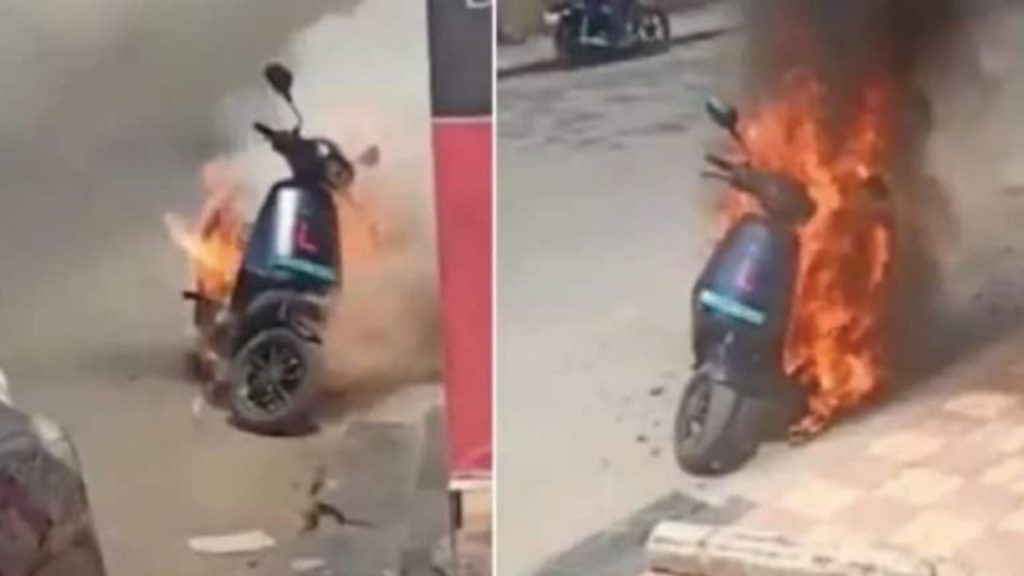Extremely Worrisome: After Ola, Okinawa, Pure EV Electric Scooter Catches Fire

In yet another incident of electric scooters catching fire in various parts of the country, a Pure EV scooter was the victim this time.
In footage captured and shared on Twitter, the two wheeler appears to be the Pure EPluto 7G which was standing on the roadside with giant plumes of smoke coming out.
An Ola electric scooter caught fire in Pune and the Okinawa two-wheeler in Tamil Nadu’s Vellore.
The government had initiated a probe into two other similar incidents.
Contents
Investigation Team
It has constituted a team of experts from Indian Institute of Science (IISC) and Centre for Fire, Explosive and Environment Safety (CFEES) to investigate the string of electric two-wheelers catching fire.
The team will visit the two cities to investigate whether structural or external factors were involved.
Both scooters had been tested and approved before launch.
The team will enquire whether a manufacturing defect led to the scooters’ demise.
Lithium Fire
The scooters are powered by lithium ion batteries.
Such batteries can catch fire if improperly manufactured, damaged or if the software that designed the battery has not properly made it.
A lithium-ion battery on fire cannot be doused by water since it immediately produces hydrogen gas and lithium-hydroxide.
Hydrogen gas is a major hindrance due to its extreme flammability.
Ola Electric said that it has also launched an investigation to find out what happened to its scooter.
Okinawa Incidents
On March 25, a new Okinawa scooter caught fire when left to charge overnight, causing the deaths of a 45-year-old man and his daughter.
This happened in Tamil Nadu.
The company said that the fire was a clear case of short circuit due to “negligence in charging the vehicle”.
Three days later another Okinawa electric scooter caught on fire in Manapparai in Tamil Nadu’s Tiruchirappalli district.
The company has not responded to this incident.
Government Response
The Ministry of Road Transport and Highways has ordered a probe into the Ola Electric and Okinawa incidents.
It has also called upon Defence Research and Development Organisation’s (DRDO) Centre for Fire Explosive and Environment Safety (CFEES) to carry out investigations.
They are expected to develop a set of SOPs around handling EV fires.
Thermal Runaway Main Cause?
It is being speculated that it happened because of a thermal runaway, where an exothermic reaction occurs inside a lithium-ion battery when it is damaged or short-circuited.
Due to overheating, the internal temperature and pressure of the battery rises at a quicker rate than can be dissipated.
Just one battery cell going into thermal runaway can produce enough heat to cause the other cells to get affected.
Unsuitable For Indian Climate?
This results in a fire that repeatedly flares up as each battery cell ruptures and releases its contents.
These incidents have brought into question electric vehicles’ ability to withstand high temperatures of the Indian summer.
Many of them have no cooling system for their batteries.
Solution
Some companies are switching to a different type of Li-ion chemistry called LFP (Lithium iron-phosphate) batteries where NMC (Nickel Manganese Cobalt) isn’t used, and the cathode material is LiFePO4 (Lithium Iron-Phosphate).
These batteries have a slightly lower energy density, but have plenty of advantages.
One, it ensures a longer life and most importantly a far lower risk of thermal runaway.
Other manufacturers, like Ather Energy (which also uses NMC batteries, but has not faced any known overheating issues) have designed cooling systems.
It makes use of a fan to force cooling air over components that may be prone to overheating.

Comments are closed, but trackbacks and pingbacks are open.